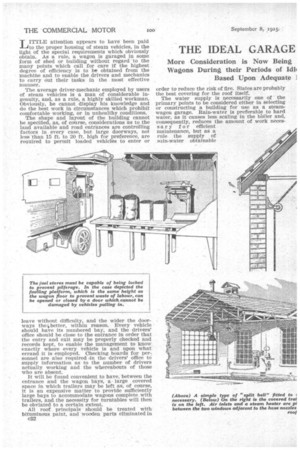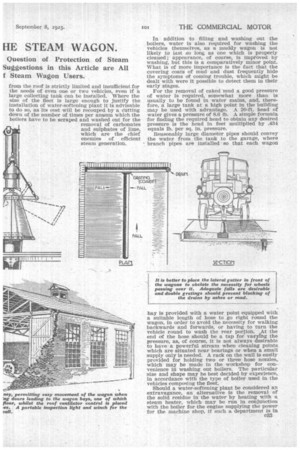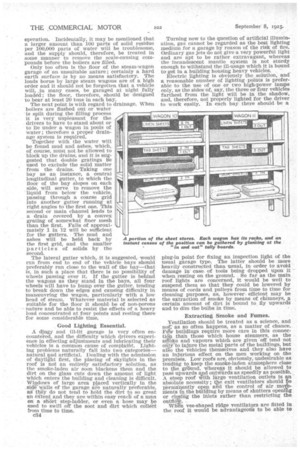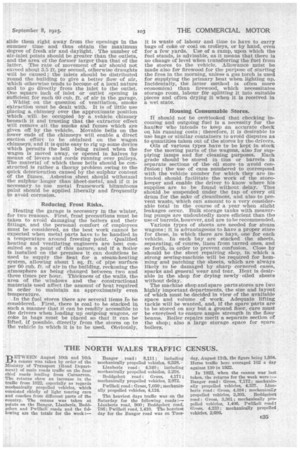• THE IDEAL GARAGE HE STEAM WAGON.
Page 16

Page 17

Page 18

Page 19

If you've noticed an error in this article please click here to report it so we can fix it.
T IT'TLE attention appears to have been paid to the proper housing of steam vehicles, in the light of the special requirements which obviously obtain. As a rule, a wagon is garaged in some form of shed or building without regard to the many points which call for care if the highest degree of efficiency is to be obtained from the machine and to enable the drivers and mechanics to carry out their tasks In the most effective manner.
The average driver-mechanic employed by users of steam vehicles is a man of considerable ingenuity, and, as a rule, a highly skilled workman. Obviously, he cannot display his knowledge and do the best work in circumstances which prohibit comfortable working, or in unhealthy conditions.
The shape and layout of the building cannot be specified, as, of course, considerations as to the land available and road entrances are controlling factors in every case, but large doorways, not less 'than15 ft. to 20 ft. high for preference, are required to permit loaded vehicles to enter or leave without difficulty, and the wider the doorways the better, within reason. Every vehicle should have its numbered bay, and the drivers' office should be close to the entrance in order that the entry and exit may be properly checked and records kept, to enable the management to know exactly where every vehicle is and upon what errand it is employed. Checking boards for personnel are also required in the drivers' office to supply information as to the number of drivers actually working and the whereabouts of those who are absent.
It will be found convenient to have, between the entrance and the wagon bays, a large covered space in which trailers may be left as, of course, It is an expensive matter to provide sufficiently large bays to accommodate wagons complete with trailers. and the necessity for turntables will then be obviated to a certain extent.
All roof principals should be treated with bituminous paint, and wooden parts eliminated in c32 order to reduce the risk of fire. Slates are probably the best covering for the roof itself.
The water supply is necessarily one of the primary points to be considered either in selecting or constructing a building for use as a steamwagon garage. Rain-water is preferable to hard water, as it causes less scaling In the boiler and, consequently, reduces the amount of work neces sary f or efficient maintenance, but as a rule the supply of 14ain-water obtainable from the roof is strictly limited and insufficient for the needs of even one or two vehicles, even if a large collecting tank can be installed. Where the size of the fleet is large enough to justify the installation of water-softening plant it is advisable to do so, as its cost will be recouped by a Cutting down of the number of times per annum which the boilers have to be 'scraped and washed out for the removal of carbonates and sulphates of lime, which are the chief enemies of efficient steam generation. In addition to filling and washing out the boilers, water is also required for washing the vehicles themselves, as a muddy wagon is not likely to last so long as one which is properly cleaned ; appearance, of course, is improved by washing, but this is a comparatively minor point. What is of more importance is the fact that the covering coats of mud and dust frequently hide the symptoms of coming trouble, which might be dealt with were it possible to detect them in their early stages.
For the removal of caked mud a good pressure of water is required, somewhat more than is usually to be found in water mains, and, therefore, a large tank at a high point in the building may be used with advantage. A 20-ft. head of water gives a pressure of 8.6 lb. A simple formula for finding the required head to obtain any desired pressure is the head in feet multiplied by .434 equals lb. per sq. in. pressure.
Reasonably large diameter pipes should convey the water from the tank to the garage, where branch pipes are installed so that each wagon bay is provided with a water point equipped with a suitable length of hose to go right round the wagon, in order to avoid the necessity for walking backwards and forwards, or having to turn the vehicle round to wash the rear portion. At the end of the hose should be a tap for varyliig the pressure, as, of course, it is not always desirable to have a powerful stream when cleaning points which are situated near bearings or when a small supply only is needed. A rack on the wall is easily provided for holding two or three hose nozzles, which may be made in the workshop for convenience in washing out boilers. The particular size and shape may be hest decided by experience, in accordance with the type of boiler used in the vehicles composing the fleet.
Should a water-softening plant be considered an extravagance, an alternative is the removal of the solid residue in the water by heating with a steam heater, which may be run in conjunction with the boiler for the engine supplying the power for the machine shop, if such a department is in operation. Incidentally, it may be mentioned that a larger amount than 100 parts of solid residue per 100,000 parts of water will be troublesome, and the supply should, therefore. be treated in some manner to remove the scale-causing compounds before the boilers are filled.
Only too often is the floor of the steam-wagon garage of an unsuitable nature ; certainly a hard earth surface is by no means satisfactory. The loads borne by large steam wagons are of a high order and it should not be forgotten that a vehicle will, ,in many cases, be garaged at night fully loaded ; the floor, therefore, should be designed to bear at least 20 tons in each bay.
The next point is with regard to drainage. When boilers are flushed out or water is spilt during the filling process it is very, unpleasant for the drivers to have to stand about or to lie under a wagon in pools of water ; therefore a proper drainage system is required.
Together with the water will be found mud and ashes, which, of course, must not be allowed to block up the drains, and it is suggested that double gratings lie used to exclude the solid matter from the drains. Taking one bay as an instance, a central longitudinal gutter, to which the floor of the bay slopes on each side, will serve to remove the liquid from below the vehicle, passing through a coarse grid into another gutter running at right angles to the first one. This second or main channel leads to a drain covered by a convex grating of somewhat finer mesh than the first. Palls of approximately 1 in 12 will be sufficient for the gutters. The mud and ashes will be held back by the first grid, and the smaller particles of solids by the second.
The lateral gutter which, it is suggested, would run from end to end of the vehicle bays should preferably run close to the wall of the bay—that is, in such a place that there is no possibility of wheels passing over it. If the gutter is behind the wagons as they stand in the bays, all four wheels will have to bump over the gutter, tending to break down the edges and causing difficulty in manceuvring the wagon, particularly with a low head of steam. Whatever material is selected as suitable for the floor it should be of non-porous nature and be able to resist the effects of a heavy load concentrated at our points and resting there for some considerable time.
Good Lighting Essential.
A dingy and garage is very often en countered, and the difficulty which drivers experience in effecting adjustments and lubricating their vehicles is a common cause of cornplaik. Lighting problems naturally fall into two categories— natural and artificial. Dealing with the admission of daylight first, the placing of skylights in the roof is not an entirely satisfactory solution, as the smoke-laden air soon blackens them and the dirt on the glass cuts down the amount of light which enters the building and cleaning is difficult. Windows of large area placed vertically in the side wallsof the garage are naturally preferable, as they do not tend to hold the dirt to so great an extent and they are within easy reach of a man on a short step-ladder, or even a hose may be used to swill off the soot and dirt which collect from time to time.
c34 Turning now to the question of artificial illumination, gas cannot be regarded as the best lighting medium for a garage by reason of the risk of fire. Ordinary gas jets do not give a very powerful light and are apt to be rather extravagant, whereas the incandescent mantle system is not sturdy enough to withstand the ill-usage which it is bound to get in a building housing heavy vehicles. Electric lighting is obviously the solution, and a reasonable number of lighting points is preferable to the use of one or two high-power lamps only, as the sides Of, say, the three or four vehicles farthest from the light will be in the shadow, and, therefore, not properly lighted for the driver to work easily. In each bay there should be a plug-in point for fixing an inspection light of the usual garage type. The latter should be more heavily construeted than usual, in order to avoid damage in case. of tools being dropped upon it when resting on the ground. So far as the main roof lights are concerned, it would be well to suspend them so that they could be lowered by means of cords and pulleys from time to time for cleaning purposes, as, however efficient may be the extraction of smoke by means of chimneys, a certain amount of dirt is bound to fly upwards and to dim the bulbs in time.
Extracting Smoke and Fumes.
Ventilation should be treated as a science, and nor, as so often happens, as a matter of chance. Fe`w buildings require more care in this connection than those which house steamers, as the silkke and vapours which are given 'off tend not orilYlo injure the metal parts of the buildings, but also the vehicles themselves and they also have an injurious effect on the men working on the premises. Low roofs are, obviously, undesirable as tending to keep the smoke-laden atmosphere close to the_ grfiund, Whereas it should be allowed to pass upwards alad outwards as speedily as possible. A steep roof with large ventilation outlets is an absolute necessity ; the exit ventilators should fie perma-nently opQn and the control of air metements in the building by means of shutters opening or closing the inlets rather than restricting the outflow.
WhTn vee-shaped ridge ventilators are fitted In the roof it would be advantageous to be able to
slide them right away from the openings in the summer time and thus obtain the maximum degree of fresh air and daylight. The number of air-inlet points should be greater than the outlets, and the area of the former larger than that of the latter. The rate of movement of air should not exceed about 3.5 ft. per second, otherwise draughts will be caused ; the inlets should be distributed round the building to give a better flow of air, which otherwise tends to become of a local nature and to go directly from the inlet to the outlet. One square inch of inlet or outlet opening is sufficient for each 60 cub. ft. of air in the garage.
Whilst on the question of ventilation, smoke extraction must be dealt with. It is of little use placing a chimney over the approximate position which will be occupied by a vehicle chimney beneath it and trusting that the extractor effect will remove all the smoke and fumes which are given off by the vehicle. Movable bells on the -lower ends of the chimneys will enable a direct suction effort to be obtained on the wagon chimneys, and it is quite easy to rig up some device which permits the bell being raised when the wagon is moved away, or opened in halves by means of levers and cords running over pulleys. The -material of which these bells should be constructed is rather a thorny problem owing to the quick deterioration caused by the sulphur content of the fumes. Asbestos sheet should withstand the sulphur longer than Sheet-metal, and if it is necessary to use metal framework bituminous paint should be applied liberally and frequently to avoid corrosion.
Reducing Frost Risks.
Heating the garage is necessary in the winter, for two reasons. First, frost precautions must be taken to avoid damaging the boilers and their fittings, and the personal comfort of employees must be considered, as the best work cannot be expected when metal parts have to be handled in a temperature around freezing point. Qualified heating and ventilating engineers are best consulted on a point of this nature, and if a boiler Is installed on the premises it can doubtless be used to supply the heat for a steam-heating system, allowing about 1 sq. ft. of pipe surface per 60 cub. ft. of air in the building, reckoning the atmosphere as being changed between two and three times per hour. Thickness of the walls, the area of the windows and the constructional materials used affect the amount of heat required in order to maintain an approximately even temperature.
In the fuel stores 'there are several items fo tie considered. First, there is coal to be stacked in such a manner that it can be readily accessible to the drivers when loading up outgoing wagons, or coke in bags must be placed so that it can be lifted, if possible, directly from the stores on to the vehicle in which it is to be used. Obviously,
it is waste of labour and time to have to carry bags of coke or coal on trolleys, or by hand, even for a few yards. Use of a ramp, upon which the fuel stands, is advisable, as it means that there is no change of level when transferring the fuel from the stores to the vehicle. Allowance must be made also for firewood for the purpose of starting the fires in the morning, unless a gas torch is used for supplying the primary heat when lighting up. Incidentally, the latter method is often more economical than firewood, which necessitates storage room, labour fOr splitting it into suitable pieces and often drying it when it is received in a wet state.
Housing Consumable Stores.
If should not be overlooked that checking incoming and outgoing fuel is a necessity for the haulier who intends to keep an accurate check on his running costs ; therefore, it is desirable to use bags or similar containers to avoid disputes as to quantities taken out of the stores by the drivers.
Oils of various types have to be kept in stock for the moving parts of the wagons, also for supplying lamps and for cleaning purposes. Each grade should be stored in tins or barrels in separate sections of the oil store to avoid confusion; the use of cans numbered to correspond with the vehicle number for which they are intended should facilitate the work of the storekeeper and enable the driver to know where his supplies are to be found without delay. Tins should be suspended under the tap of every oil drum for the sake of cleanliness, and also to prevent waste, which can amount to a very considerable total in the course of a year when slight leakages occur. Bulk storage tanks with measuring pumps are undoubtedly more efficient than the use of barrels, however, and are to be recommended.
Various types of sheets are needed for steam wagons; it is advantageous to have a proper store for these, in which there are bays, one for each vehicle. In each bay are stacked the sheets, separating, of course, linen from tarred ones, and so forth, in order to prevent confusion. Close by should be the sheet repairing shop, in which a strong sewing-machirie will be required for hemming and patching the sheets, which are always likely to be damaged by sharp cornered cases, sparks and general wear and tear. Heat is desirable in the shop for drying newly oiled sheets without delay. The machine shop and spare parts stores are two highly important departments, the size and layout of which must be decided in view of the available space and volume of work. Adequate lifting tackle will be wanted, and, if the spare parts are to be stored on any but a ground floor, care must be exercised to ensure ample strength in the floor beams. Boiler repairs merit a separate section of the shop; also a large storage space for spare boilers.






























